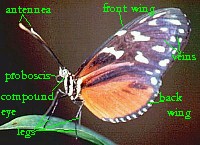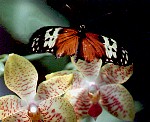|
Welcome to the Butterfly
Pages
|
Many people love butterflies. These insects are gentle and beautiful. Butterflies live in tropical rainforests, woodlands, fields, and prairies. There are even some butterflies
that, "live on cold mountain tops, and others live in hot
deserts." (World Encyclopedia) There are many types of butterflies. In Papua New Guinea the largest of butterflies lives. This butterfly is called the Queen Alexandra's Bird-wing and it has a wingspan
of approximately 11 inches. The smallest butterfly is named the Western Pygmy
Blue, which lives in North America. This small butterfly has a wingspan of 3/8
inch. The word ‘butterfly' is, "from the Old English word buterfleoge,
meaning butter and flying creature" (World Encyclopedia). |
Butterfly Bodies
Butterflies are insects. Therefore, they have 6 jointed legs, 2 antennae, and 3 body segments.
Here is a picture of the parts of a butterfly.
 |
It's a Butterfly's Life (Metamorphosis)
The stages of a butterfly's life are: |
1) egg
2)larva(caterpillar) |
3)pupa(cocoon or chrysalis)
4)adult butterfly |
Lepidoptera
The insect group called Lepidoptera is made of butterflies and moths. The word Lepidoptera comes from the Greek word: lepis(meaning scale); and pteron(meaning wing).
Differences between butterflies and moths
|
Butterflies |
Moths |
|
Fly during the day |
Most fly at dusk or night |
|
Have knobs at the ends of their antennae |
Most antennae are not knobbed |
|
Most have slender, hairless bodies |
Most plump, furry bodies |
|
Most rest with wings held upright over their
bodies |
Most rest with wings spread out |

What do butterflies do during the winter?
Butterflies hibernate or migrate to warmer
areas during the winter.
"Just before hibernation the blood of a larva, pupa, or adult produces substances called glycols. These substances are related to the antifreeze used in automobiles. Scientists believe the production of glycols may be triggered by the decreasing daylight that occurs as winter approaches. The presence of glycols enables the insect to survive even the severest cold. After warm weather returns, the glycols are gradually replaced by normal blood
substances." (World Encyclopedia)
To continue to the next Butterfly page click

Butterfly Links
Children's Butterfly Site
The Butterfly Web Site
World Butterfly Fort Lauderdale Attraction
The Butterfly Zone
Tropical Butterflies
Butterfly Site
Texas Butterflies
Butterflies of North America
Butterflies in Houston
Blake School Monarch Project
The Butterfly World
Butterflies in your backyard
Butterflies and Gardens
|

